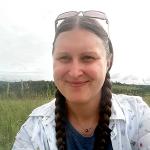Select updates from our team of restoration ecologists, entomologists, plant ecologists, and researchers.
The Xerces Society manages the largest pollinator conservation program in the world. We work with people from all walks of life to create habitat for bees, butterflies, and other beneficial insects—and hundreds of thousands of acres of flower-rich habitat have been planted. We also offer certifications: Bee Better Certified for farmers and food companies who are committed to supporting pollinator conservation in agricultural lands, and Bee City USA and Bee Campus USA for cities and colleges dedicated to making their community safer for pollinators.
With staff based in more than a dozen states, and offering a diverse array of expertise, it can be challenging to summarize the impactful work being done. We compile updates from pollinator team members into regular digests. In this edition, Kelly Gill offers an update on the New England Pollinator Partnership, and Jennifer Hopwood shares her experience of creating a backyard pond—not our usual fare for pollinator updates, but a great addition to any wildlife garden.
A Call to Action: The New England Pollinator Partnership Invites Landowner Participants to Help Protect At-Risk Pollinators Across Six States.
Kelly Gill, Senior Pollinator Conservation Specialist, Northeast/Mid-Atlantic Region
We are excited to announce that this year marks the official kickoff of the New England Pollinator Partnership (NEPP). This multi-state collaboration between the Natural Resources Conservation Service (NRCS), the U.S. Fish and Wildlife Service, the Xerces Society, and several other agencies and organizations began to take shape in 2017 to address decline in native pollinator populations across New England. The partnership is specifically intended to benefit three target species: the monarch butterfly, the yellow banded bumble bee, and the federally endangered rusty patched bumble bee. Practices implemented by participating landowners, however, will benefit many pollinator species and other wildlife as well as improve overall farmland biodiversity.
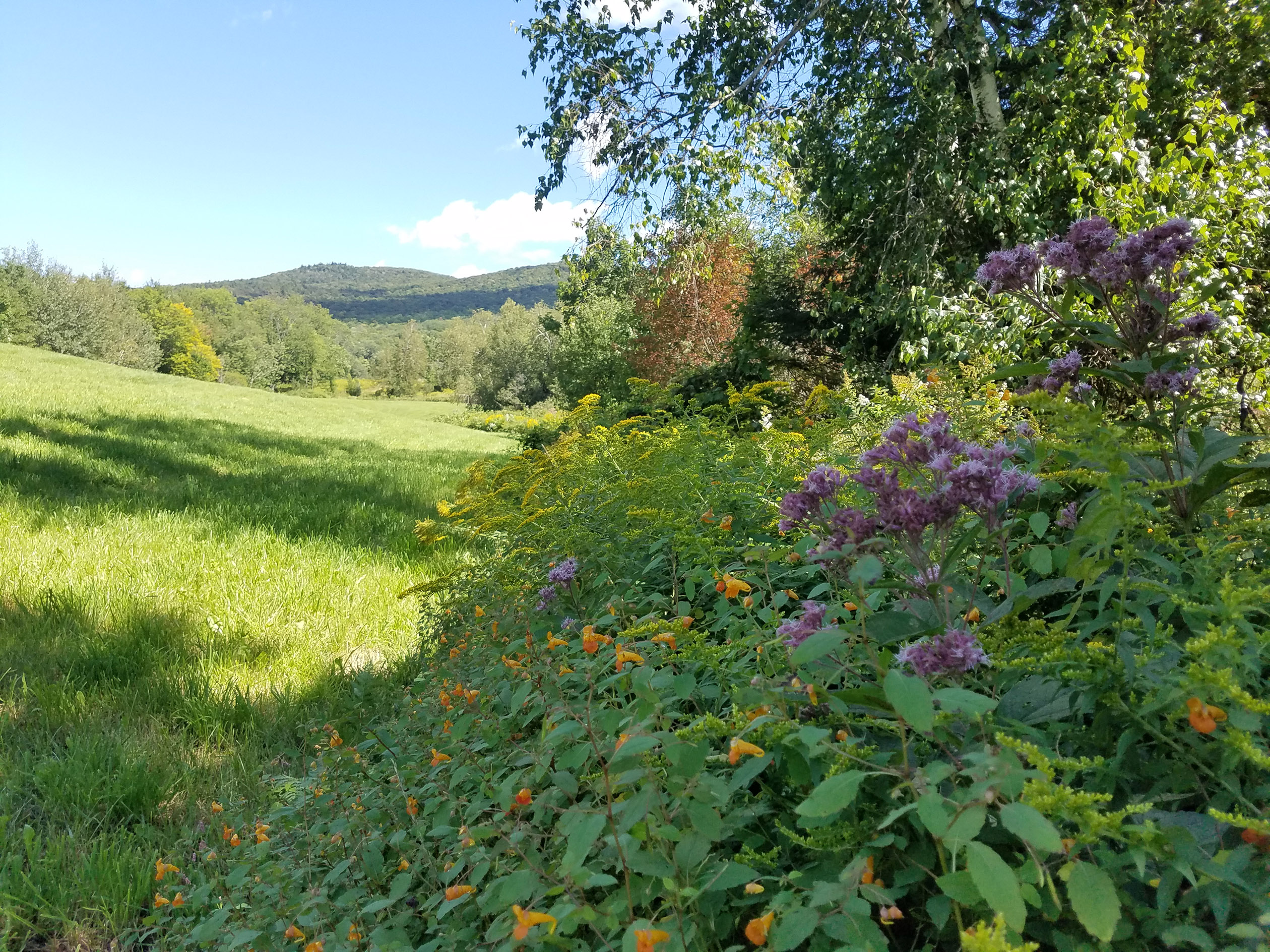
The flowering border along this hayfield in Vermont offers a late season buffet of pollen and nectar for a variety of pollinators. The jewelweed, joe pye weed, and goldenrod in bloom are also high-value native plants for the principal target species for the New England Pollinator Partnership, the rusty patched bumble bee, yellow banded bumble bee, and monarch butterfly. (Photo: Xerces Society / Alina Harris.)
NEPP is a 25-year conservation effort and agreement that provides technical and financial assistance to projects on working lands—farms, dairies, pastures, forests—in Connecticut, Rhode Island, Massachusetts, Vermont, New Hampshire, and Maine to implement conservation practices benefiting native pollinators. NRCS staff and Xerces’ partner biologists will work with landowners to help them create a conservation plan for their property. There are a variety of practices available to NEPP participants including managing natural habitats, managing invasive plant species, establishing wildflower habitat, installing flowering hedgerows and field borders, planting riparian buffers, and adopting integrated pest management systems that protect pollinators and their habitats from pesticide risk. One advantage for landowners participating in NEPP is that they will be provided Endangered Species Act regulatory predictability when practices and associated conservation measures are implemented and maintained according to the conservation plan.
The goals for NEPP are set state by state, but together the partners aim to engage 1,182 farmers and growers in pollinator conservation practices and establish 7,680 acres of habitat by 2025—but with the participation of enough landowners, we can exceed our goals!
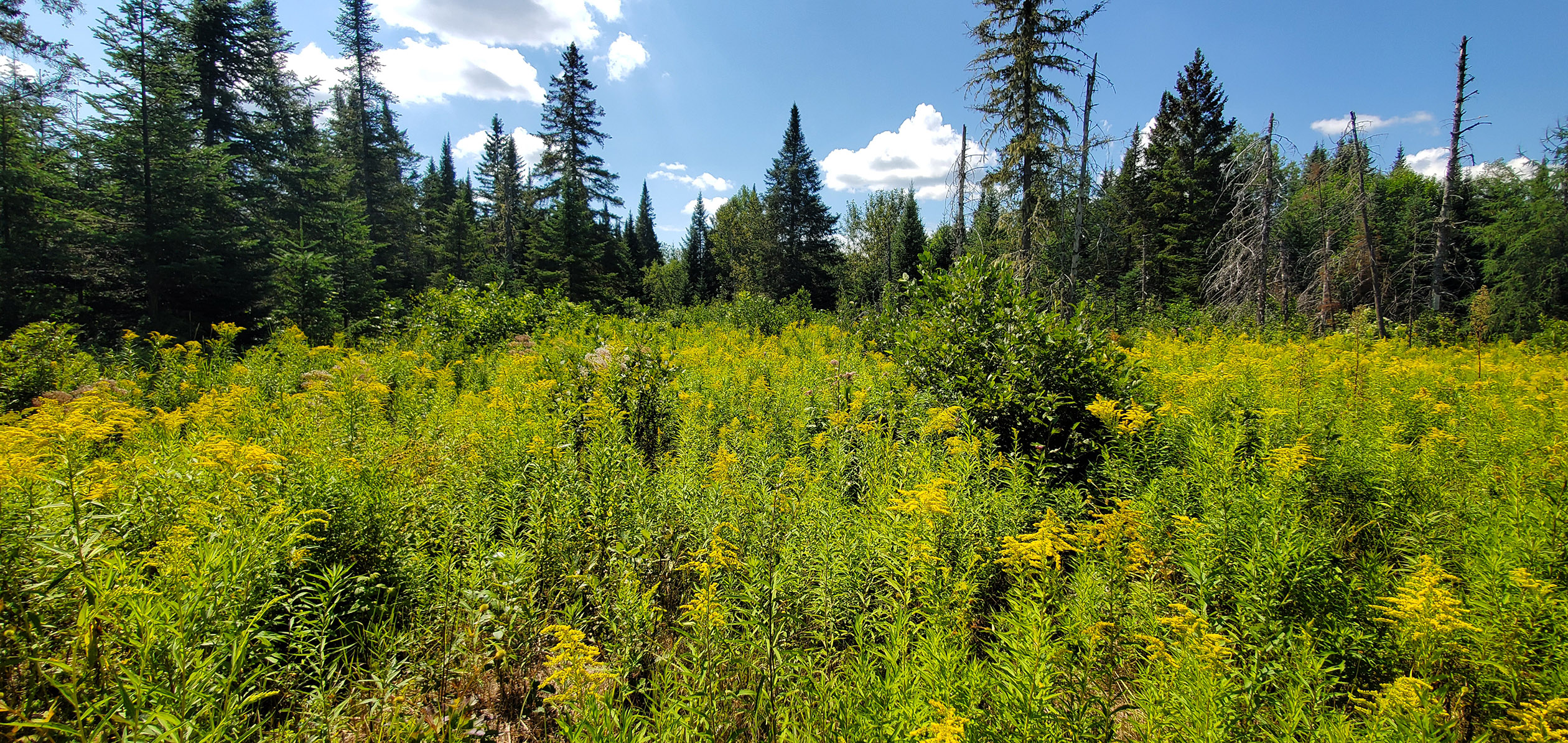
Forest margins in Northern Maine can be periodically mowed to create dynamic edges that increase plant structural diversity and habitat niches. Pushing back woody growth allows sunlight to penetrate through the canopy and encourages growth of wildflowers and flowering shrubs such as goldenrod, milkweed, asters, and dogwood. (Photo: Xerces Society / Hannah Mullally.)
Backyard Ponds Bring Life, Fun, and Peace
Jennifer Hopwood, Senior Pollinator Conservation Specialist, Midwest and Great Plains, and Rights of Way Lead
This past winter, my son Theo became captivated with the book On Meadowview Street, by Henry Cole. In this story, a young girl delights in the few wildflowers in her new yard and over time, transforms her yard to create habitat as homes for wildlife. Eventually her neighbors are also inspired to add meadows, trees, or ponds to their yards. We read that book night after night, and long before spring arrived Theo was determined to create a pond in our own yard to help attract more life.
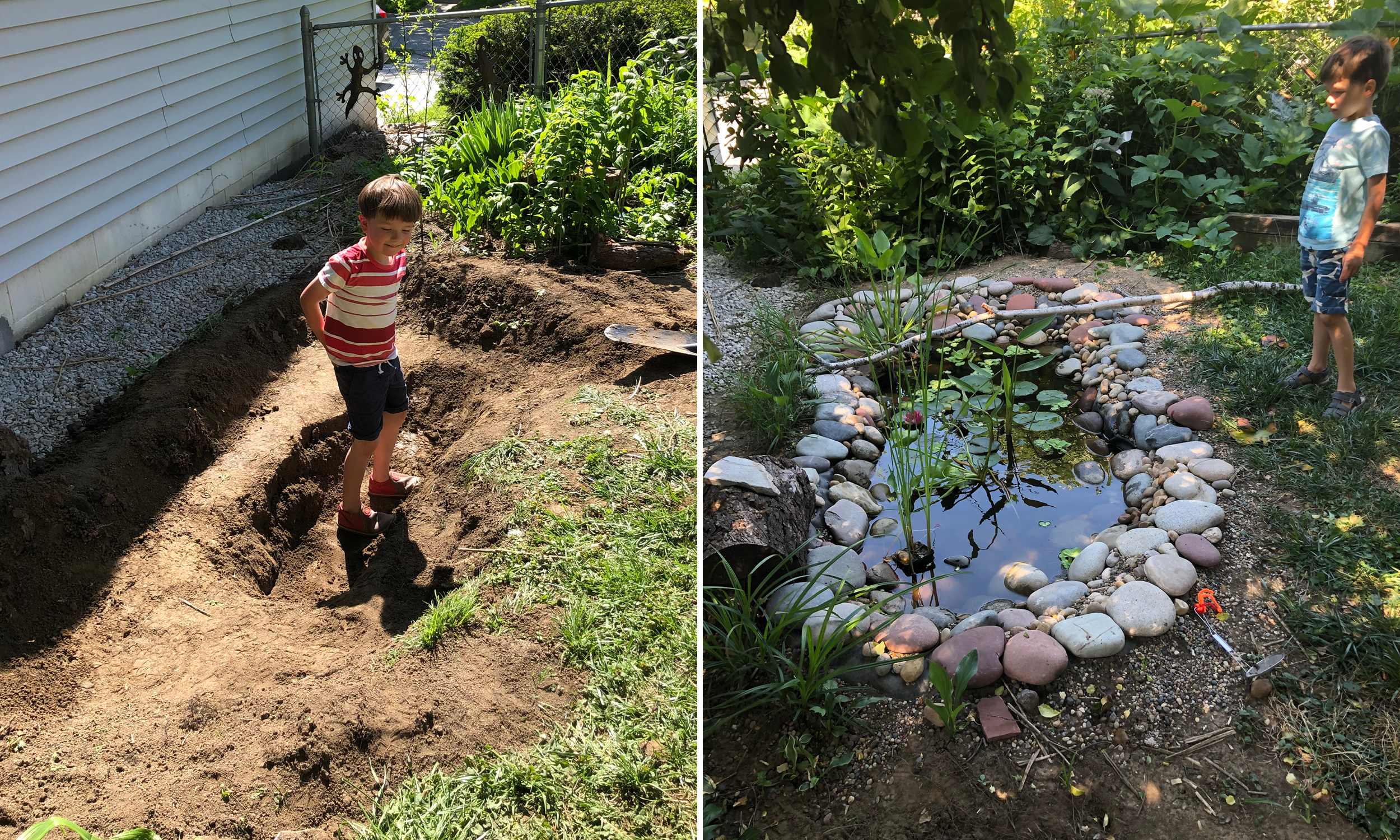
Creating a pond became a family project this spring. After the hard work of digging and laying down a liner, the pond was filled from the rain barrel and native aquatic plants were added to the pond.
This spring, with the pandemic underway, we were spending more time at home and more time outside. The pond became a way for us to manage stress by focusing on something we could change, and the hope that change could bring. Our urban backyard is an odd shape and small in size, but in between a vegetable bed, a tree, and patch of wildflowers, we had a corner where only invasive creeping Charlie seemed to grow. It was satisfying to dig deep into that spot to create a new space for wildlife. We dug enthusiastically at first and then begrudgingly, until we could level out what became the bottom of the pond and create a small, shallow ridge. After laying down a liner and placing rocks and gravel on top, we moved bucket after bucket from the rain barrel to fill up the pond. Next we added native aquatic plants to the pond and planted sedges around the perimeter. And then we waited for critters to come.
Birds found the pond immediately, using it for a quick drink or as a place to bathe. Rabbits and raccoons came to drink as well. Next came tiny water fleas (Daphnia) that zipped around in the water eating algae. Without much water movement or predators, the pond also became a home to mosquito larvae. Many, many larvae. Envisioning a cloud of adult mosquitoes, we added a small solar-powered pump that added a little movement, enough to substantially decrease the mosquito population. An exuberant moment came in July when Theo found a damselfly larva while dipping a sieve in the water. Then we spotted several species of dragonflies perching near the pond. Recently we brought up dragonfly larvae in cupped hands. Our pond construction was not fancy (a bit sloppy might be more accurate). Its conservation footprint may be small. But it has been amazing to watch as more and more small animals begin to call it home.
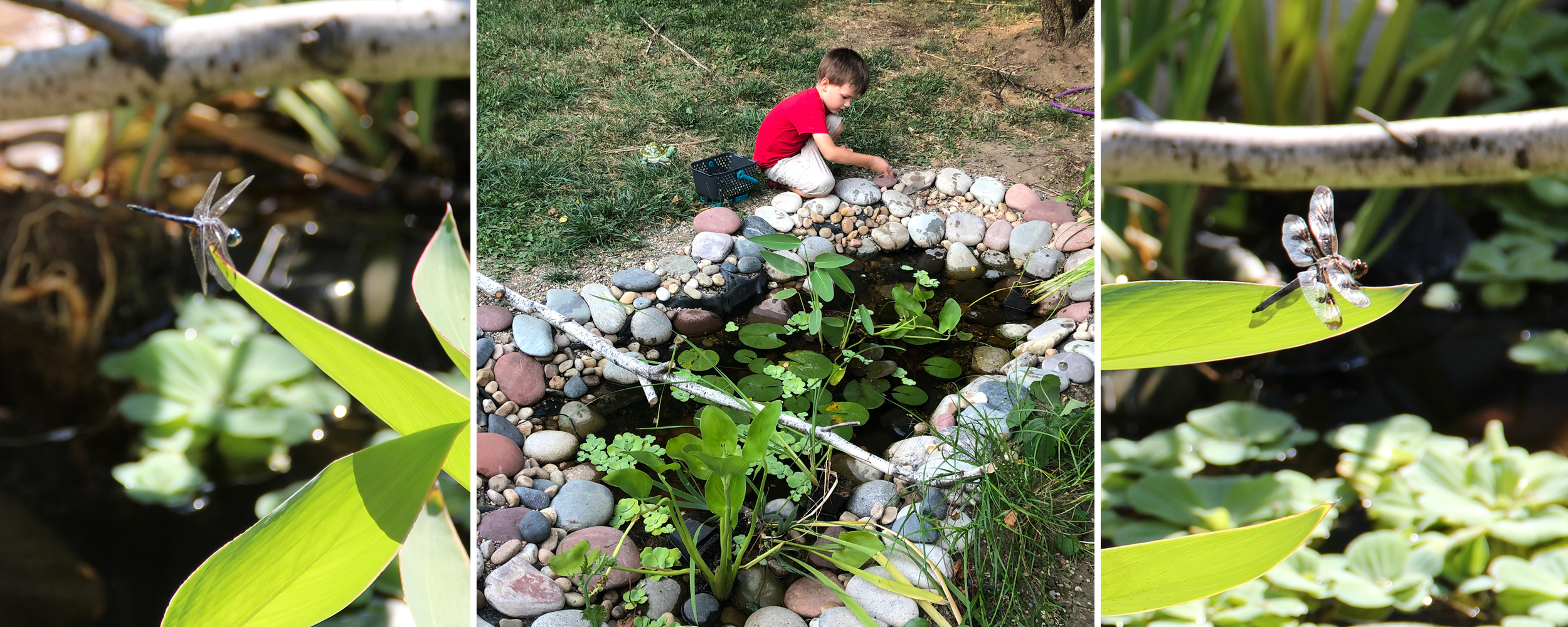
During its first summer, the pond provided a home for several species of insects, including dragonflies such as the blue dasher (left) and twelve-spotted skimmer (right), as well as a relaxing spot for people.
To find out more about creating a backyard pond to support dragonflies, damselflies, and other wildlife, download Backyard Ponds: Guidelines for Creating & Managing Habitat for Dragonflies and Damselflies from the Xerces website.
Further Reading
Download a guide to creating and managing backyard ponds.
Find out how you can help Bring Back the Pollinators.


